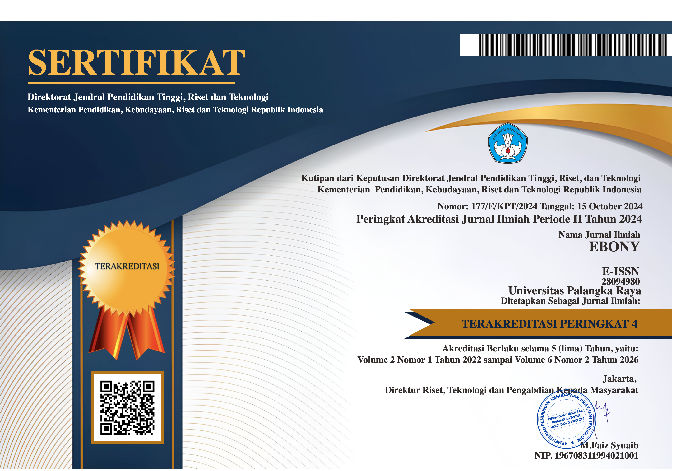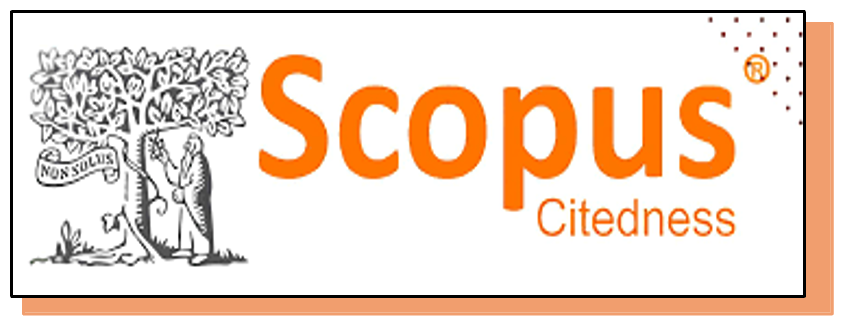EcoLingua: Optimizing Indonesian Learning through Lumen5 in Digital Era
DOI:
https://doi.org/10.37304/ebony.v5i1.18467Keywords:
digital learning, environmental education, Indonesian language, Lumen5, video-based learningAbstract
This scholarly investigation examines the evolution and application of Lumen5-based video instructional media for Indonesian language pedagogy with a specific emphasis on environmental themes. Employing a Research and Development (R&D) methodology through the ADDIE framework, the inquiry produced five interactive videos that address various environmental challenges, including forest fires, flooding, waste management, landslides, and the maintenance of school hygiene. The research encompassed extensive evaluations involving 10th-grade students, utilizing a combination of qualitative and quantitative methodologies to evaluate the efficacy of the video-centric learning paradigm. Findings indicated a 30% enhancement in students' understanding of environmental concepts in comparison to conventional text-based instructional strategies. Moreover, 80% of the students indicated heightened engagement with the educational content, while 75% exhibited advancements in their digital literacy competencies. The utilization of Lumen5's AI-driven platform was found to be effective in producing interactive, visually stimulating materials that are appealing to Generation Z learners. By aligning with the Merdeka Curriculum and integrating local environmental contexts, this inquiry presents a scalable framework for augmenting both language instruction and environmental awareness in the context of the digital era. The outcomes imply that AI-enhanced video learning platforms possess the potential to effectively reconcile the divide between traditional educational approaches and modern instructional requirements while fostering environmental consciousness among learners.
Downloads
References
Ashirbekov, A., Srymbetov, T., Dikhanbayeva, D., & Rojas-Solórzano, L. (2020). Lumen degradation effect on fluorescent-to-LED switching: techno-economic viability for a lecture room. Clean Technologies and Environmental Policy. https://doi.org/10.1007/S10098-020-01921-Z
Chandra, M., Dhanendra, N., Renato, R., Fredyan, R., & Pranoto, H. (2023). Developing Interactive Learning Media Design for Futuristic Learning Activities. 2023 15th International Congress on Advanced Applied Informatics Winter (IIAI-AAI-Winter), 135-138. https://doi.org/10.1109/iiai-aai-winter61682.2023.00033.
Creswell, J. W., & Creswell, J. D. (2024). Research design: Qualitative, quantitative, and mixed methods approaches (6th ed.). SAGE Publications.
Gössling, B., & Daniel, D. (2018). Video analysis in Design-Based Research – Findings of a project on self-organised learning at a vocational school. https://doi.org/10.15460/EDER.2.2.1270
Digital Innovations in Education. (2022). Advances in Higher Education and Professional Development Book Series.https://doi.org/10.4018/978-1-6684-4083-4.ch011
Fauzi, I. (2023). Challenges of English teachers in the digital era. Proceeding of UHAMKA International Conference on ELT and CALL (UICELL). Jakarta, 14-15 December 2023, pp. 11—20.
Haviz, M. (2016). Research and development; penelitian di bidang kependidikan yang inovatif, produktif dan bermakna. Ta’dib. https://doi.org/10.31958/JT.V16I1.235
Hobbs, R. (2006). Reading the Media: Media Literacy in High School English. . https://doi.org/10.5860/choice.44-6360.
Leiker, D., & Cukurova, M. (2023). Generative AI for Learning: Investigating the Potential of Learning Videos with Synthetic Virtual Instructors. https://doi.org/10.1007/978-3-031-36336-8_81
Lestari, S., & Setiyawan, R. (2020). Technology Era, Global English, CLIL: Influence and its Impact on English Teaching for Young Learners in Indonesia. https://doi.org/10.1088/1755-1315/469/1/012094
Lin, M., Chen, H., & Liu, K. (2017). A Study of the Effects of Digital Learning on Learning Motivation and Learning Outcome. Eurasia journal of mathematics, science and technology education, 13, 3553-3564. https://doi.org/10.12973/EURASIA.2017.00744A.
Lucas, P., & Giesen, J. (2021). Lumen: A software for the interactive visualization of probabilistic models together with data. The Journal of Open Source Software. https://doi.org/10.21105/JOSS.03395
Luo, Y. (2024). Enhancing educational interfaces: Integrating user-centric design principles for effective and inclusive learning environments. Applied and Computational Engineering. https://doi.org/10.54254/2755-2721/64/20241427.
Martatiyana, D. R., Usman, H., & Lestari, H. D. (2023). Application of the addie model in designing digital teaching materials. (2023). Jurnal Pendidikan Dan Pengajaran Guru Sekolah Dasar. https://doi.org/10.55215/jppguseda.v6i1.7525
Mertasari, N. M. S. (2022). Summative Evaluation of ICT-Based Learning Media. Journal of Education Research and Evaluation. https://doi.org/10.23887/jere.v6i4.54695
Noetel, M., Griffith, S., Delaney, O., Harris, N., Sanders, T., Parker, P., Del Pozo Cruz, B., & Lonsdale, C. (2021). Multimedia Design for Learning: An Overview of Reviews With Meta-Meta-Analysis. Review of Educational Research, 92, 413 - 454. https://doi.org/10.3102/00346543211052329.
Park, H. R. (2022). A Study on Class Satisfaction with ADDIE Model. Keolcheo Keonbeojeonseu. https://doi.org/10.22143/hss21.13.2.117
Permatasari, R., Suarman, S., & Gimin, G. (2024). Examining The Impact of Using Learning Media On Students’ Learning Motivation and Learning Outcomes. International Journal of Educational Best Practices. https://doi.org/10.31258/ijebp.v8n1.p88-102.
Rahmandhani, H., & Utami, E. (2022). Comparative Analysis of ADDIE and ASSURE Models in Designing Learning Media Applications. Jurnal Educative: Journal of Educational Studies. https://doi.org/10.30983/educative.v7i2.6005.
Selfa-Sastre, M., Pifarré, M., Cujba, A., Cutillas, L., & Falguera, E. (2022). The Role of Digital Technologies to Promote Collaborative Creativity in Language Education. Frontiers in Psychology. https://doi.org/10.3389/fpsyg.2022.828981
Samino, S. (2023). 10 Aplikasi Kecerdasan Buatan (AI) Gratis yang Mempermudah Guru dalam Membuat Media Pembelajaran. https://guruinovatif.id/artikel/10-aplikasi-kecerdasan-buatan-ai-gratis-yang-mempermudah-guru-dalam-membuat-media-pembelajaran
Seo, K., Fels, S., Yoon, D., Roll, I., Dodson, S., & Fong, M. (2020). Artificial Intelligence for Video-based Learning at Scale. Proceedings of the Seventh ACM Conference on Learning @ Scale. https://doi.org/10.1145/3386527.3405937.
Tessmer, M. (2018). Planning and conducting formative evaluations: Improving the quality of education and training (2nd ed.). Routledge.
Yang, Y. (2024). Innovative Strategies for Language Education in the Context of Media Convergence - From Traditional to Digital Media. Applied Mathematics and Nonlinear Sciences. https://doi.org/10.2478/amns-2024-2379.
Downloads
Published
How to Cite
Issue
Section
License
Copyright (c) 2025 Izhar, Fatma Yuniarti, Aan Nurjannah

This work is licensed under a Creative Commons Attribution 4.0 International License.











